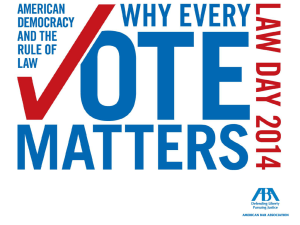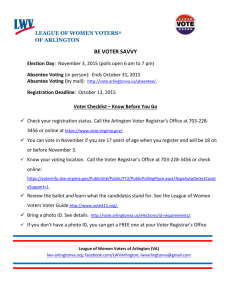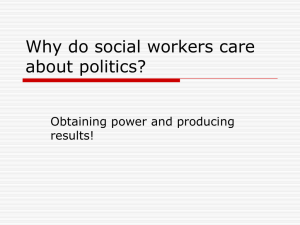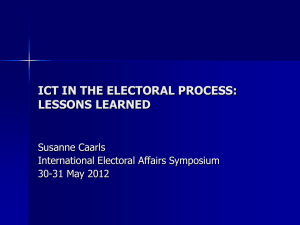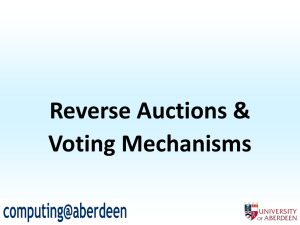chapter6- Voters and Voter Behavior
advertisement
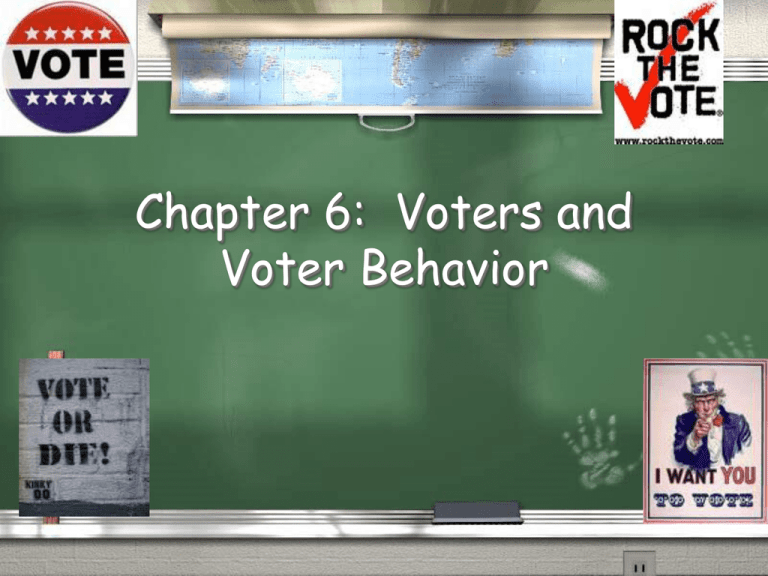
Chapter 6: Voters and Voter Behavior Voter Turnout in 2004 / / / / Whites - 67% Blacks - 60% Hispanics - 47% Asians - 44% / / / 65 + 45 + 18-24 - 79% - 70% - 58% Women- 65% Men - 62% Voting Miscellanea Write ins - Can win, but not likely - 20,767 for write-in POTUS candidates (0.02%) - 10 states don’t allow write-ins Absentee Voting - 20% voted before election day - 21 staes require an excuse to vote absentee by mail Ohio and early voting Oregon and vote by mail More Miscellanea Party of the President loses seats in the Midterm Dow, not Paula Jones Who do undecided voters go to at the last minute? Time Zones Arizona Proposition 200 - $1 Million Voter Reward HAVA Help America Vote Act 2002 - Required “provisional ballots” where eligibility would be determined later - States determine how to verify differently - Joe Wurzelbacher or Joe Wurzlebacher Felonious Behavior Felony Disenfranchisement - 48 states bar felons (including those on probation & parole) and 10 states bar ex-felons - 4.7 million people barred from voting (2% of citizens) - Disproportionate numbers of minorities and poor (1.8 million of 4.7 million are black) - Could this turn an election? Florida has highest number of felons in nation and some of toughest laws. 31% of FLA’s black Males are barred From voting Sentencing Disparity? Since 1988, possession of five grams of crack cocainean amount equal to five packets of sugar substitutelanded a person in jail for 5 years But people caught with cocaine powder would have to possess 100 x that amount, or 500 grams, to get the same 5-year stint behind bars. More Miscellanea Rally around the flag Coat-tails Favorite Son Ebay the vote in 2000 - started @ $5 and pulled at $10,000 I. The Right to Vote A. History of Voting Rights 1. Suffrage/franchise- right to vote 2. Electorate- potential voting population 3. 2 trends: gradual elimination of voter restrictions; Fed. Gov. assuming power 4. Five stages of the extension of voting rights: a. 1789b. 1870 c. 1920 Suffrage and Civil Rights d. 1960s: 1. Voting Rights Act of 1965 2. 23rd Amendment: 3. 24th Amendment- Civil Rights Act of 1964 ` e. 26th Amendment Power to Set Voting Qualifications 1. Power is reserved to States with exception of 4 restrictions: II. Voter Qualifications A. Universal Requirements 1. Citizenship 2. Residence 3. Age B. Other qualifications 1. Registration a. Motor Voter Law, 1995: 2. Persons denied the vote a. Mental institutions b. convicted of serious crimes c. dishonorable discharge III. Voter Behavior A. B. Nonvoters (origin of the word “idiot”) 1. Millions who do not participate Size of the problem 1. Nonvoters more common in ????? 2. Millions of nonvoters among those who vote- How is that possible? a. Ballot fatigue: C. Why People Do Not Vote 1. “Cannot Voters”2. Actual nonvoters: a. government taken over by politicians b. lack political efficacy- what is political efficacy? 3. Factors affecting turnout: a. b. c. biggest reason- 4. Comparing Voters and Nonvoters a. voters- high income, education, occupation, strong party ID, believe voting is important b. nonvoters- under 35, single, unskilled, rural south c. women more likely than men d. degree of party competition e. high sense of political efficacy more likely to vote regardless of other factors 1. Combination of factors; not one single D. Voters and Voting Behavior 1. Study voting behavior- political socialization: 2. Factors that influence voters: a. personal characteristics: age, race, income, occupation, education, religion E. b. voters group affiliations: family, co-workers, friends, etc. Sociological Factors 1. We already discussed in Chapter 5 F. Psychological Factors- voters perception of politics 1. Party ID- best predictor a. straight ticket voting b. has lost some significance: 1. Increase in split-ticket voting 2. Increase in # of independents


